Frankfurt, officially Frankfurt am Main (German: [ˈfʁaŋkfʊʁt ʔam ˈmaɪn] ; Hessian: Frangford am Maa, pronounced [ˈfʁɑŋfɔɐ̯t am ˈmãː]; lit. "Frank ford on the Main"), is the most populous city in the German state of Hesse. Its 791,000 inhabitants as of 2022 make it the fifth-most populous city in Germany, and it is the only city in the country rated as an "alpha world city" according to GaWC. Located in the foreland of the Taunus on its namesake Main, it forms a continuous conurbation with the n...Read more
Frankfurt, officially Frankfurt am Main (German: [ˈfʁaŋkfʊʁt ʔam ˈmaɪn] ; Hessian: Frangford am Maa, pronounced [ˈfʁɑŋfɔɐ̯t am ˈmãː]; lit. "Frank ford on the Main"), is the most populous city in the German state of Hesse. Its 791,000 inhabitants as of 2022 make it the fifth-most populous city in Germany, and it is the only city in the country rated as an "alpha world city" according to GaWC. Located in the foreland of the Taunus on its namesake Main, it forms a continuous conurbation with the neighboring city of Offenbach am Main and its urban area has a population of over 2.3 million. The city is the heart of the larger Rhine-Main metropolitan region, which has a population of more than 5.8 million and is Germany's second-largest metropolitan region after the Rhine-Ruhr region and the fourth biggest metropolitan region by GDP in the European Union. Frankfurt's central business district lies about 90 km (56 mi) northwest of the geographic center of the EU at Gadheim in Lower Franconia. Like France and Franconia, the city is named after the Franks. Frankfurt is the largest city in the Rhenish Franconian dialect area.
Frankfurt was a city state, the Free City of Frankfurt, for nearly five centuries, and was one of the most important cities of the Holy Roman Empire, as a site of Imperial coronations; it lost its sovereignty upon the collapse of the empire in 1806, regained it in 1815 and then lost it again in 1866, when it was annexed (though neutral) by the Kingdom of Prussia. It has been part of the state of Hesse since 1945. Frankfurt is culturally, ethnically and religiously diverse, with half of its population, and a majority of its young people, having a migrant background. A quarter of the population consists of foreign nationals, including many expatriates. In 2015, Frankfurt was home to 1,909 ultra high-net-worth individuals, the sixth-highest number of any city. As of 2023, Frankfurt is the 13th-wealthiest city in the world and the second-wealthiest city in Europe (after London).
Frankfurt is a global hub for commerce, culture, education, tourism and transportation, and is the site of many global and European corporate headquarters. Due to its central location in the former West Germany, Frankfurt Airport became the busiest in Germany, one of the busiest in the world, the airport with the most direct routes in the world, and the primary hub for Lufthansa, the national airline of Germany and Europe's largest airline. Frankfurt Central Station is Germany's second-busiest railway station after Hamburg Hbf, and Frankfurter Kreuz is the most-heavily used interchange in the EU. Frankfurt is one of the major financial centers of the European continent, with the headquarters of the European Central Bank, Deutsche Bundesbank, Frankfurt Stock Exchange, Deutsche Bank, DZ Bank, KfW, Commerzbank, DekaBank, Helaba, several cloud and fintech startups, and other institutes. Automotive, technology and research, services, consulting, media and creative industries complement the economic base. Frankfurt's DE-CIX is the world's largest internet exchange point. Messe Frankfurt is one of the world's largest trade fairs. Major fairs include the Music Fair and the Frankfurt Book Fair, the world's largest book fair. With 108 consulates, among which the largest is the US Consulate General, Frankfurt is second to New York City among non-capital cities in regards to consulate seats.
Frankfurt is home to influential educational institutions, including the Goethe University with the Universitätsklinikum Frankfurt (de) (Hesse's largest hospital), the FUAS, the FUMPA, and graduate schools like the FSFM. The city is one of two seats of the German National Library (alongside Leipzig), the largest library in the German-speaking countries and one of the largest in the world. Its renowned cultural venues include the concert hall Alte Oper, continental Europe's largest English theater and many museums, 26 of which line up along the Museum Embankment, including the Städel, the Liebieghaus, the German Film Museum (de), the Senckenberg Natural Museum, the Goethe House and the Schirn art venue. Frankfurt's skyline is shaped by some of Europe's tallest skyscrapers, which has led to the term Mainhattan. The city has many notable green areas and parks, including the Wallanlagen, Volkspark Niddatal, Grüneburgpark, the City Forest, two major botanical gardens (the Palmengarten and the Botanical Garden Frankfurt) and the Frankfurt Zoo. Frankfurt is the seat of the German Football Association (Deutscher Fußball-Bund – DFB), is home to the first division association football club Eintracht Frankfurt, the Löwen Frankfurt ice hockey team, and the basketball club Frankfurt Skyliners, and is the venue of the Frankfurt Marathon and the Ironman Germany.
historical affiliations
Roman Empire, pre 475
Francia, ca. 475–843
East Francia, 843–962![]() Holy Roman Empire, 962–1806
Holy Roman Empire, 962–1806![]() Free City of Frankfurt, 1372–1806
Free City of Frankfurt, 1372–1806![]() Grand Duchy of Frankfurt, 1806–1813
Grand Duchy of Frankfurt, 1806–1813 ![]() Free City of Frankfurt, 1813–1866
Free City of Frankfurt, 1813–1866![]() Kingdom of Prussia, 1866–1871
Kingdom of Prussia, 1866–1871![]() German Empire, 1871–1918
German Empire, 1871–1918 ![]() Weimar Republic, 1918–1933
Weimar Republic, 1918–1933 ![]() German Reich, 1933–1945
German Reich, 1933–1945![]() American occupation zone, 1945–1949
American occupation zone, 1945–1949![]() West Germany, 1949–1990
West Germany, 1949–1990 ![]() Germany, 1990–present
Germany, 1990–present
At the western borders of Frankfurt lies the Kapellenberg as part of the Taunus with one of the first Stone Age cities in Europe.[1] The Celts had different settlements in the Taunus mountains north of Frankfurt, the biggest one the Heidetrank Oppidum. The first traces of Roman settlements established in the area of the river Nidda date to the reign of Emperor Vespasian in the years 69 to 79 AD. Nida (modern Heddernheim, Praunheim) was a Roman civitas capital (Civitas Taunensium).
Alemanni and Franks lived there, and by 794, Charlemagne presided over an imperial assembly and church synod, at which Franconofurd (alternative spellings end with -furt and -vurd) was first mentioned. It was one of the two capitals of Charlemagne's grandson Louis the German, together with Regensburg. Louis founded the collegiate church, rededicated in 1239 to Bartholomew the Apostle and now Frankfurt Cathedral.[2]
Frankfurt was one of the most important cities in the Holy Roman Empire. From 855, the German kings were elected and crowned in Aachen. From 1562, the kings and emperors were crowned and elected in Frankfurt, initiated for Maximilian II. This tradition ended in 1792, when Francis II was elected. His coronation was deliberately held on Bastille Day, 14 July, the anniversary of the storming of the Bastille. The elections and coronations took place in St. Bartholomäus Cathedral, known as the Kaiserdom (Emperor's Cathedral), or its predecessors.
The Frankfurter Messe ('Frankfurt Trade Fair') was first mentioned in 1150. In 1240, Emperor Frederick II granted an imperial privilege to its visitors, meaning they would be protected by the empire. The fair became particularly important when similar fairs in French Beaucaire lost attraction around 1380. Book trade fairs began in 1478.
In 1372, Frankfurt became a Reichsstadt (Imperial Free City), i.e., directly subordinate to the Holy Roman Emperor and not to a regional ruler or a local nobleman.
In 1585, Frankfurt traders established a system of exchange rates for the various currencies that were circulating to prevent cheating and extortion. Therein lay the early roots for the Frankfurt Stock Exchange.
Frankfurt managed to remain neutral during the Thirty Years' War, but suffered from the bubonic plague that refugees brought to the city. After the war, Frankfurt regained its wealth. In the late 1770s the theater principal Abel Seyler was based in Frankfurt, and established the city's theatrical life.[3]


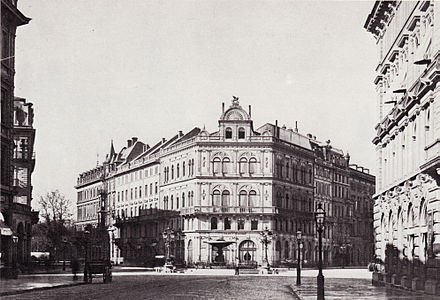
Following the French Revolution, Frankfurt was occupied or bombarded several times by French troops. It remained a Free city until the collapse of the Holy Roman Empire in 1805/6. In 1806, it became part of the principality of Aschaffenburg under the Fürstprimas (Prince-Primate), Karl Theodor Anton Maria von Dalberg. This meant that Frankfurt was incorporated into the Confederation of the Rhine. In 1810, Dalberg adopted the title of a Grand Duke of Frankfurt. Napoleon intended to make his adopted son Eugène de Beauharnais, already Prince de Venise ("prince of Venice", a newly established primogeniture in Italy), Grand Duke of Frankfurt after Dalberg's death (since the latter as a Catholic bishop had no legitimate heirs). The Grand Duchy remained a short episode lasting from 1810 to 1813 when the military tide turned in favor of the Anglo-Prussian-led allies that overturned the Napoleonic order. Dalberg abdicated in favor of Eugène de Beauharnais, which of course was only a symbolic action, as the latter effectively never ruled after the ruin of the French armies and Frankfurt's takeover by the allies.
Frankfurt as a fully sovereign stateAfter Napoleon's final defeat and abdication, the Congress of Vienna (1814–1815) dissolved the grand-duchy and Frankfurt became a fully sovereign city-state with a republican form of government. Frankfurt entered the newly founded German Confederation (till 1866) as a free city, becoming the seat of its Bundestag, the confederal parliament where the nominally presiding Habsburg Emperor of Austria was represented by an Austrian "presidential envoy".
After the ill-fated revolution of 1848, Frankfurt was the seat of the first democratically elected German parliament, the Frankfurt Parliament, which met in the Frankfurter Paulskirche (St. Paul's Church) and was opened on 18 May 1848. In the year of its existence, the assembly developed a common constitution for a unified Germany, with the Prussian king as its monarch. The institution failed in 1849 when the Prussian king, Frederick William IV, declared that he would not accept "a crown from the gutter".
Frankfurt after the loss of sovereignty View of Frankfurt am Main, including the Alte Brücke (Old Bridge), by Gustave Courbet (1858)
View of Frankfurt am Main, including the Alte Brücke (Old Bridge), by Gustave Courbet (1858)Frankfurt lost its independence after the Austro-Prussian War in 1866 when Prussia annexed several smaller states, among them the Free City of Frankfurt. The Prussian administration incorporated Frankfurt into its province of Hesse-Nassau. The Prussian occupation and annexation were perceived as a great injustice in Frankfurt, which retained its distinct western European, urban and cosmopolitan character. The formerly independent towns of Bornheim and Bockenheim were incorporated in 1890.
In 1914, the citizens founded the University of Frankfurt, later named Goethe University Frankfurt. This marked the only civic foundation of a university in Germany; today it is one of Germany's largest.
From 6 April to 17 May 1920, following military intervention to put down the Ruhr uprising, Frankfurt was occupied by French troops.[4] The French claimed that Articles 42 to 44 of the peace treaty of Versailles concerning the demilitarization of the Rhineland had been broken.[5] In 1924, Ludwig Landmann became the first Jewish mayor of the city, and led a significant expansion during the following years. During the Nazi era, the synagogues of the city were destroyed and the vast majority of the Jewish population fled or was killed.[6]
During World War II, Frankfurt was the location of a Nazi prison for underage girls with several forced labour camps,[7] a camp for Sinti and Romani people (see Romani Holocaust),[8] the Dulag Luft West transit camp for Allied prisoners of war,[9] and a subcamp of the Natzweiler-Struthof concentration camp.[10]
Frankfurt was severely bombed in World War II (1939–1945). About 5,500 residents were killed during the raids, and the once-famous medieval city center, by that time the largest in Germany, was almost completely destroyed. It became a ground battlefield on 26 March 1945, when the Allied advance into Germany was forced to take the city in contested urban combat that included a river assault. The 5th Infantry Division and the 6th Armored Division of the United States Army captured Frankfurt after several days of intense fighting, and it was declared largely secure on 29 March 1945.[11]
After the end of the war, Frankfurt became a part of the newly founded state of Hesse, consisting of the old Hesse-(Darmstadt) and the Prussian Hesse provinces. The city was part of the American Zone of Occupation of Germany. The Military Governor for the United States Zone (1945–1949) and the United States High Commissioner for Germany (HICOG) (1949–1952) had their headquarters in the IG Farben Building, intentionally left undamaged by the Allies' wartime bombardment.
Frankfurt was the original choice for the provisional capital city of the newly founded state of West Germany in 1949. The city constructed a parliament building that was never used for its intended purpose (it housed the radio studios of Hessischer Rundfunk). In the end, Konrad Adenauer, the first postwar Chancellor, preferred the town of Bonn, for the most part because it was close to his hometown, but also because many other prominent politicians opposed the choice of Frankfurt out of concern that Frankfurt would be accepted as the permanent capital, thereby weakening the West German population's support for a reunification with East Germany and the eventual return of the capital to Berlin.
Postwar reconstruction took place in a sometimes simple modern style, thus changing Frankfurt's architectural face. A few landmark buildings were reconstructed historically, albeit in a simplified manner (e.g., Römer, St. Paul's Church, and Goethe House). The collection of historically significant Cairo Genizah documents of the Municipal Library was destroyed by the bombing. According to Arabist and Genizah scholar S.D. Goitein, "not even handlists indicating its contents have survived."[12]

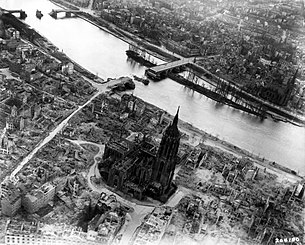
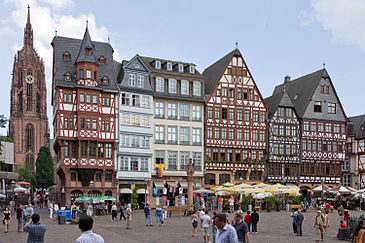
The end of the war marked Frankfurt's comeback as Germany's leading financial hub, mainly because Berlin, now a city divided into four sectors, could no longer rival it. In 1948, the Allies founded the Bank deutscher Länder, the forerunner of Deutsche Bundesbank. Following this decision, more financial institutions were re-established, e.g. Deutsche Bank and Dresdner Bank. In the 1950s, Frankfurt Stock Exchange regained its position as the country's leading stock exchange.
Frankfurt also reemerged as Germany's transportation hub and Frankfurt Airport became Europe's second-busiest airport behind London Heathrow Airport in 1961.
During the 1970s, the city created one of Europe's most efficient underground transportation systems.[13] That system includes a suburban rail system (S-Bahn) linking outlying communities with the city center, and a deep underground light rail system with smaller coaches (U-Bahn) also capable of travelling above ground on rails.
In 1998, the European Central Bank was founded in Frankfurt, followed by the European Insurance and Occupational Pensions Authority and European Systemic Risk Board in 2011.


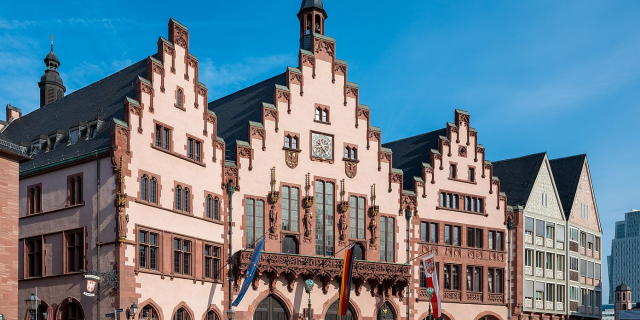












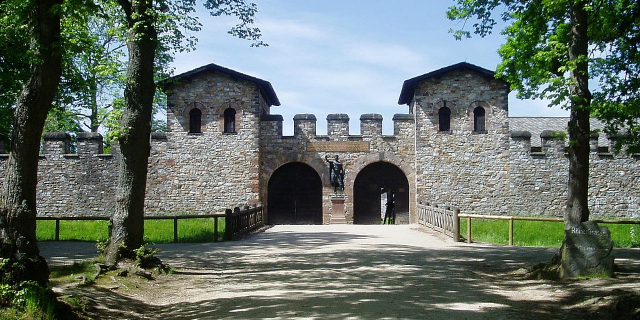














Add new comment